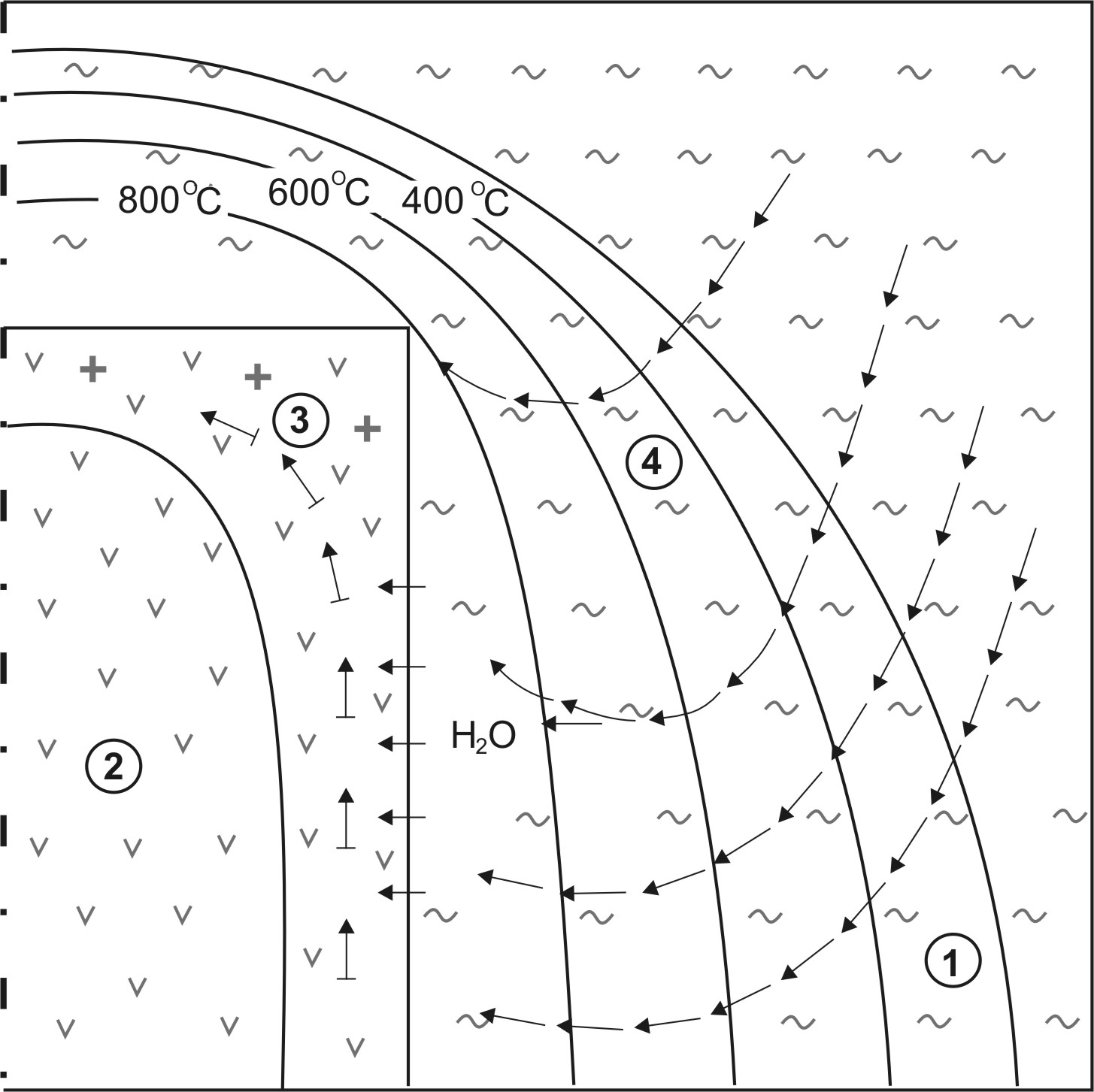|
THE MODE OF GRANITE MELT FORMATION AND ACCUMULATION ON THE DIFFERENT EARTH CRUST DEPTH Institute of Mneralogy UrB RAS, Miass, Cheliabinsk, Russia, е-м.iminchf@ilmeny.ac.ru
The most complex and unsolved problem of metamorphic rock granitization and autochthonous granite formation is the metasomatism function as a substratum composition change factor. It was experimentally established that granitic melt is able to generate not only on the quartz and feldspar grains contact, but on their surface if grains do not contact to one another at the water fluid presence. This is because the contrary diffusion flows appear in the system containing the eutectic components. The melt appears in the point where these flows meet in the rock Migmatite will form in gneiss or crystalline schist layer enriching by quartz or alkali feldspar on this condition. This process has been going at constant chemical rock composition by the diffusion component redistribution within the metamorphic rock thickness. The migmatite formation is the first stage of the granitization. The granitic melt separation and its accumulation in the generation zone happen on the second stage. The forming of a big granitic bodies contrast with respect to the country rock composition is the main argument in the support of metasomatic rocks transformation before their fusion. There is alternative point of view proposed by Escola. He believes that granitic melt is able to wring out from the partially smelt rock and form the batolite size body. Miller (1982) showed that plastic layered material flow, which layers have different viscosity leads to its separation and wring out the low viscosity material (Muller, 1982). By this means the specific fusion mechanism and plastic flow of the partially smelt layered migmatite material open up possibilities for big granitic body formation without metasomatic transformation of the initial metamorphic rock. There are two questions when we try to work out the model of a big granitic massive origin in mezozone. 1. Where does the granitic melt generation happene? 2. By which way is the volume occupied by granit filled out? D.S. Kordjinsky proposed that granite is formed as a result of country rock processing by the transmagmatic solution. But nobody can explain how this solution moves through granitic melt. It is generally agreed that granite is formed at liquidus temperature at presence of water. In actuality its temperature is higher, then the liquidus one. The water-saturated granitic melt is able to go up for distance of some km in these conditions. The big granitic batolites are placed above the regional metamorphism area (Perkalina,1966) It allow to propose that the granitic melt generation zone was on this depth and granitic melt had gone up to mesoabissal level from this depth. There was no big magmatic chamber on the mesoabissal level and granitic melt fill up the batolite volume gradually, layer by layer (Anfilogov, 2002).
Fig. 1.The
fluid motion in the thermal fild of magmatic chamber. 1- country
rock; 2 - basaltic melt 3- Water saturated basaltic melt 4 –
Fluid flows direction.
i – fluid flow dencity g/sm2∙sec; M – molecular mass of water; P1 and P2 the fugacity of water in porous fluid and in the basaltic melt; T1 and T2 – temperature in country rock and in the melt; r – microcapillary radius; L – microcapillary length. The pore radius for water molecular flow possibility is: r ≤ 10-5 sm if temperature is more then 800oC. As evident from the equation water moves from the area with high water fugacity and low temperature to the area of low fugacity and high temperature. The water saturated basaltic melt has low density and goes to the upper part of the magmatic chamber. The fraction crystallization of water saturated melt gave birth to the acid one formation.
References Anfilogov V.N. (2002) Ways of granite melt formation and accumulation. Lithosphere. N4. P.78-88. (in Russian) Anfilogov V.N. The mechanism of the complementary basalt-rhyolite series of rocks formation. Lithosphere petrology and origin of diamond. Abstracts of International Symposium. Novosibirsk, 2008. P.122. Miller Y.V. Layered and sublayered rocks flow and its function in the structure formation // Geotectonics.1982. No 6. P.88-96 Perkalina T.V. Geology of Central Kazakhstan Hercynian granitoids. L. Izd-vo of LSU. 240p. (in Russian)
|

